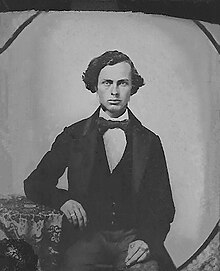Stedman Machine Company
Stedman owes its origin to the market that was created in the South many years ago for iron nuts and screws for use by planters and others in assembling their cotton and hay presses.
His father, who had been a soldier in the Revolutionary War, moved the family to Connecticut while Nathan was a child.
As the business developed, the company began manufacturing sawmill and stationary steam engines.
5, which has been restored by South Bend Replicas, and resides on loan from Franklin County, Indiana, in the Indianapolis State Museum.
1, has found its way into private ownership and was last seen on public display during a Sesquicentennial celebration in Muncie, Indiana, where it was rumored to have been fired with a live shot, skipping the ball across the water of a reservoir in the area.
After the war, the country began to recover; and the Stedman steam engine hit peak production.
Another monument to the company was furnishing of the castings for the Vine and Sycamore Street cable lines in Denver and New York City.
A new plant was built in the Cochran area, on a site still formerly occupied by an Ohio and Mississippi Rail Road service garage where it exists today.
That same year, the Stedman family sold the business to Cincinnati industrialists Stuart P. Sutphin, Chester A. Peebles and Perin Langdon.
The machinery division's product line expanded to include crushing, pulverizing, disintegrating, mixing and screening equipment for the fertilizer, chemical, meat packing, crushed stone, sand and gravel and glass industries.
The foundry division continued to operate, and in 1970 installed equipment for cupola emission control.
In January, 1993, administrative, sales and engineering personnel moved into a newly erected office building.
Stedman crushers have primarily been identified with the aggregate industry, but Stedman is gaining new ground in industrial markets for their line of crushers as well as their ability to develop complete crushing, screening, and conveying systems.
Management consists of Christopher J. Nawalaniec, President; Eric Marcotte, Director of Units and Systems Sales; Aaron Potter, Director of Operations; Jason C. Potter, Vice President of Engineering; Doug E. Weber, Parts Sales Manager.
1886 - Stedman builds disintegrator #1 also known as a cage mill for Oakland Pressed Brick, in Zanesville, Ohio.
1890 - Stedman ships its first international disintegrator to Kennedy Brick Machinery Manufacturing Co., in Liverpool, England.
1912 - Stedman is purchased by Stuart P. Sutphin, Chester A. Peebles and Perin Langdon and moves to Cochran Indiana where it exists today.
1929-1940 - During the Great Depression Stedman kept the economy moving forward by producing Hammer Mills, Disintegrators, Mixers, Crushers, and screens.
1999 - The first Stedman V-Slam(tm) vertical shaft impactor is shipped to OMG Americas-Apex OP, St. George, UT.
2009 - Stedman celebrates 175 years in business and is also awarded 3 patents for improvements to vertical shaft impactors.
2010 - Stedman completes a colossal 60 ton MegaSlam(tm) primary for use in an underground limestone mine.







